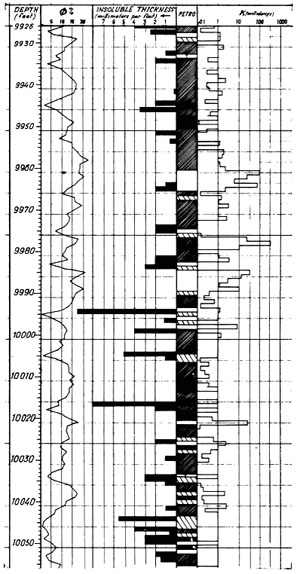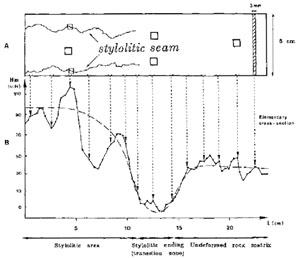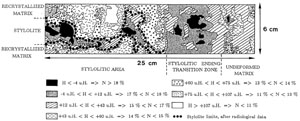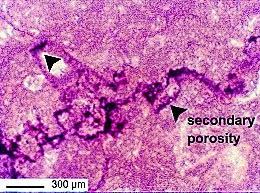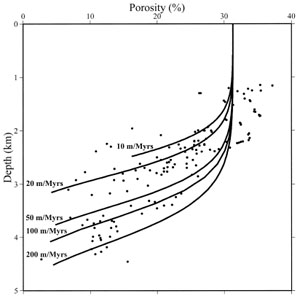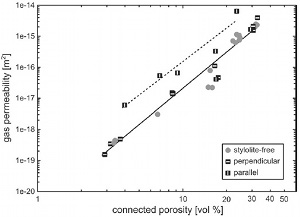| |||||||||
|
|
|||||||||
|
|
|||||||||
| Porosity and Permeability of Pressure Solution Seams | |||||||||
|
Pressure solution reduces porosity by compaction and cementation as the dissolved material is deposited at pore space nearby or somewhere else (Groshong, 1988). For an idealized rock made up of arrays of nearly spherical grains shown in Figure 1 (Renard et al., 1999), pressure solution will truncate the grains at their contacts and fill the pore space around the grains and reduce the porosity (Sprunt and Nur, 1976). This process is called chemical compaction. In open systems, dissolved material may be carried by the circulating fluid for a long distance, even to another formation, before being re-deposited. In closed systems, on the other hand, dissolved materials may tend to be re-deposited nearby due to limited formation fluid mobility. Many investigators proposed porosity changes associated with pressure solution seams and the resulting lower permeability than their host rock (Nelson, 1981; Koepnick, 1984; Tremolieres, 1984). However, the nature of this change is not simple. Braithwaite (1988) proposed that some stylolites were conduits for fluid. Experimental results indicated that a single seam may affect a zone from 0.5 feet (Wong and Oldershaw, 1981) to about 5 feet (Dunnington, 1967) in width to either side. Tremolieres (1984) presented log data showing lower porosity in zones with high concentration of pressure solution seams (Figure 2) from a Cretaceous carbonate reservoir, Abu Dhabi, United Arab Emirates.
Carrio-Schaffhauser et al. (1990) reported high radiological density (Figure 3 and Figure 4) indicative of fine matrix structure and low porosity, along tectonic pressure solution seams from core samples in Cretaceous limestone from south-eastern France. They also identified low porosity zones at the tips of the seams and interpreted them as a transient phenomenon. Guilhaumon et al. (2004) documented secondary porosity change (Figure 5) within the flat parts of stylolites in limestone from Pakistan.
It is well known that porosity may decrease with depth in sedimentary basins as a result of compaction and pressure solution. Renard et al. (1999) compared their model with data from sandstone of Norwegian margin (Ramm, 1992) and showed that the porosity generally decreases with depth as shown in Figure 6. Within the first 2 km, mechanical compaction dominates and compaction due to pressure solution is very slow because the temperature is low and quartz kinetics are very slow. The curves in Figure 6 represent the amount of compaction induced by pressure solution. The curves do not represent porosity variations above 2 km. Below 2 km, both the numerical curves and the field data show the trend that porosity continually decreases with depth. If the dissolved silica forms quartz cementation around grains close by, the strength of the sandstone is increased along with decreased porosity. Safaricz and Davison (2005) reported significant reductions in porosity associated with pressure solution seams in chalk from the North Sea. The initial porosity ranges from 70% to 80%. In the first tens to hundreds of meters of burial, porosity is then reduced to 38% to 48% by mechanical compaction. Continued burial leads to further diagenesis by extensive pressure solution, reducing the porosity to 15% to 30% at 1500 to 2000 m depth and to 2% to 25% at 2700 to 3300 m depth. Pressure solution seams, especially when they are thick and continuous can cause reservoir compartmentalization and channeled fluid flow parallel to them. Dunnington (1967) reported stylolites in carbonate reservoirs in Iraq trapping oil. Wall et al. (2006) supported this by showing the lack of bitumen in unsheared pressure solution seams, in contrast to the presence of bitumen in a connected network of other fractures. A recent study by Heap et al. (2014) concluded that the stylolites that they studied in the laboratory result in lower permeability in a direction normal to them (Figure 7). However, they also suggested that the stylolites are made up of short discontinuous components and therefore they may not impact regional fluid flow. It appears that the reported influences of pressure solutions on fluid flow show significant variations and care should be taken in evaluating each situation case by case. | |||||||||
| Reference: |
|||||||||
| Braithwaite, C.J.R., 1988 Carrio-Schaffhauser, E., Raynaud, S., Latière, Mazerolle, F., 1990 Dunnington, H.V., 1967 Groshong, R.H., Jr, 1988 Guilhaumou, N., Benchilla, L., Mougin, P., Dumas, P., 2004 Heap, M.J., Baud, P., Reuschle, T., Meredith, P., 2014 Koepnick, R.B., 1984 Nelson, R.A., 1981 Ramm, M., 1992 Renard, F., Ortoleva, P., Gratier, J.P., 1999 Safaricz, M., Davison, I., 2005 Sprunt, E.S., Nur, A., 1976 Tremolieres, P., 1984 Wall, B.R.G., Girbacea, R., Mesonjesi, A., Aydin, A., 2006 Wong, P.D., Oldershaw, A., 1981 |
|||||||||
|
Readme | About Us | Acknowledgement | How to Cite | Terms of Use | Ⓒ Rock Fracture Knowledgebase |
|||||||||

